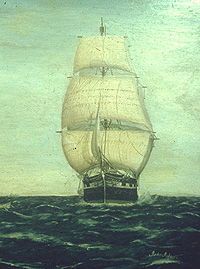- Mechanics’ Institute
- Asia
- Oceania
 Africa
Africa
- Europe
- United States of America
 Bibliography
Bibliography
The Margaret Rait and Easter Island

John Lars Johnson (Stockholm, Sweden 1876– 1950 Saint John, N.B.)
Saint John Whalers (detail showing the Margaret Rait), 1920-1930
oil on board; 78.7 x 88.9 cm
Gift of the artist, 1931
The Margaret Rait was a whaling ship built in St. Andrew’s in 1831 and registered in Saint John. In October 1840, the Margaret Rait embarked on its last whaling voyage, an expedition to the Galapagos Islands, headed by Captain James Doane Coffin of Barrington, Nova Scotia. During the voyage, Captain Coffin kept a journal, which describes the trials and tribulations of whaling and life at sea. Whaling was an arduous occupation and required long months aboard a ship to reach the goal of a full cargo. The 1840 expedition lasted almost four years, the majority of which was spent in the South Pacific.
Having secured nearly 2200 barrels of sperm oil, the Margaret Rait began its long journey homeward, sailing south along the coast of South America. To replenish their stock of provisions, the crew stopped at Easter Island for approximately five days. In his journal, Captain Coffin gives a vivid account of their visit, which took place just after Christmas in 1843. Coming in close to shore, but not landing, he and the crew bartered whale blubber for sweet potatoes, yams, bananas and sugar cane. Captain Coffin expressed admiration for the Islanders, lauding their skills at swimming and characterizing them as “exceedingly animated and cheerful, almost continually laughing, and [possessing] nothing savage or ferocious either in look, manner or gesture.” Oddly, Captain Coffin makes no mention of receiving the two barkcloth figures. We learn of this gift from the Easter Islanders from other sources.
After nearly four years at sea the Margaret Rait returned to Saint John in June 1844, at which time her crew presented the two figures to the local Mechanics’ Institute. A complete list of the crew has yet to be discovered, but Captain Coffin recorded some names in his journal: first mate Joseph Godfrey Kenney (who became a renowned sea captain in Saint John), Mr. Taylor, Mr. Hooper, Mr. Chase (son of Captain Chase of Nantucket), and Harry Bluff a native of the Hawaiian Islands.
Both of their Easter Island artefacts are made of barkcloth or tapa over a framework of reeds. Such figures are now exceedingly rare. Worldwide, only seven are known, including these two.
The New Brunswick Museum possesses three other figures from Easter Island, all wood carvings. Their history is so far completely unknown. It is likely, however, that they were brought back by New Brunswick seafarers just as were those from the crew of the Margaret Rait.
Quite possibly these very same figures were reported in the Mechanics' Institute annual report of 1845 as “two idols from Eastern Isles”. In the Mechanics' Institute’s manuscript catalogue of ethnological specimens dated 1 May 1883 they are described as “Idols worshipped by the Inhabitants of Easter Islands”.




